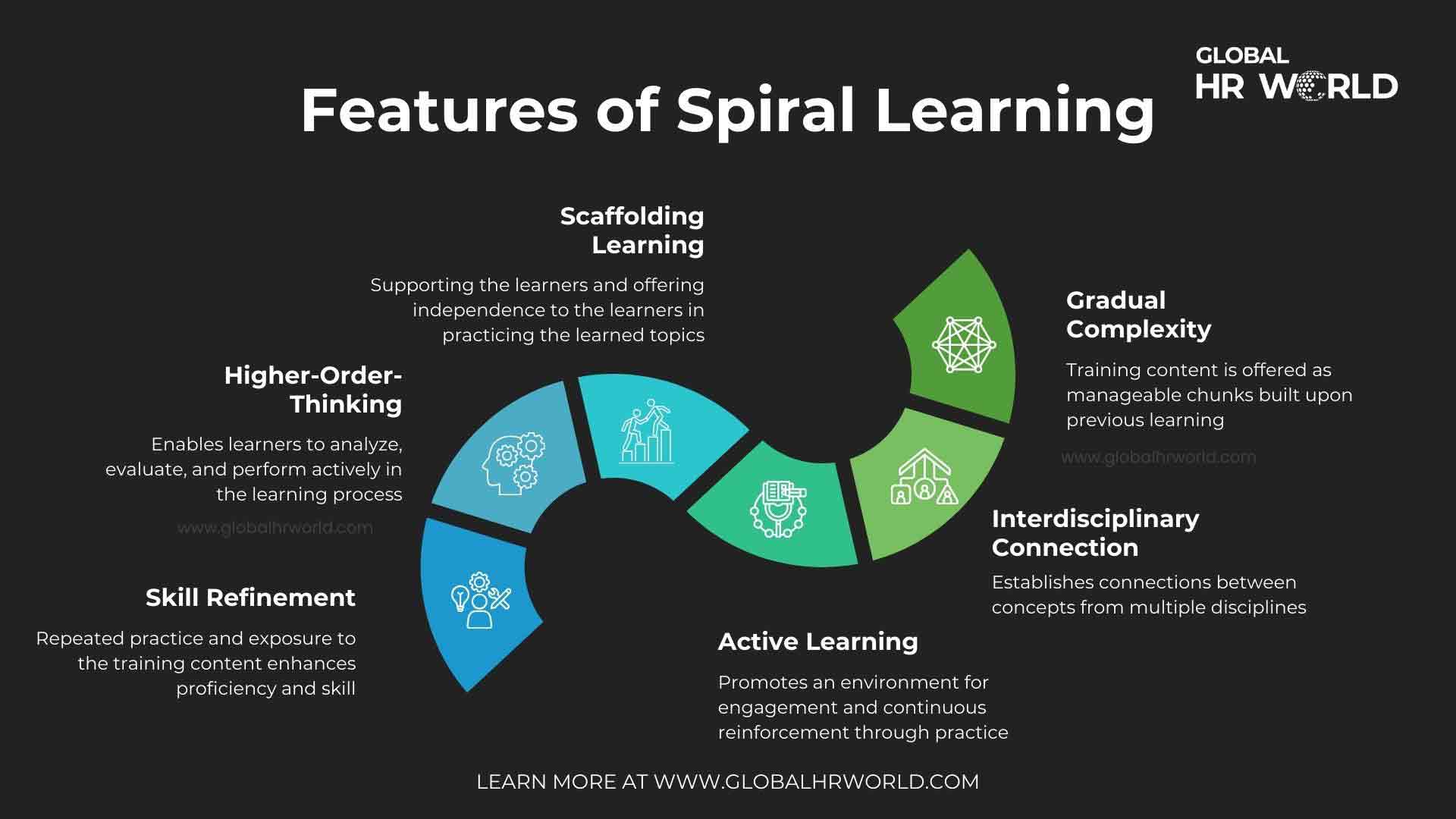Spiral learning is a powerful approach to workplace training that ensures better comprehension of the concepts. This adaptive learning model well suits corporate training encouraging employees to comprehend the concepts in-depth. But what exactly is spiral learning, what are its features and benefits, and how can organizations successfully implement the spiral model in their training programs? Delve into this entire blog for valuable insights, Read on!
What is Spiral Learning?
Spiral learning is a teaching approach that involves introducing core concepts at the basic level and revisiting and building upon these concepts gradually. The model was formulated by Jerome Bruner, an American psychologist and cognitive learning theorist in the 1960s. The 3 major principles of the spiral approach are:
Cyclical
The learning process is not a one-time event but a continuous process where the learner visits the basic concepts multiple times.
Increasing Depth
Instead of merely repeating the concepts learned, the complexity of learning increases with each time the learner revisits the concept deepening understanding.
Prior Knowledge
The new learning is built upon the existing knowledge leading to effective and meaningful learning experiences.
Adopting these three major principles, organizations can offer a culture of continuous and structured learning contributing to employee development.
Features of Spiral Learning
Spiral learning focuses on building knowledge on prior learning and helps the learners develop expertise and skills in the area. Here are the major features of spiral learning.

Gradual Complexity
A major feature of spiral learning is the gradual complexity with foundational to advanced progression of skill development. Instead of offering advanced concepts in isolation, the training content is offered as manageable chunks built upon the previous learning increasing complexity over time.
Interdisciplinary Connection
Spiral learning encourages interdisciplinary connection by not confining the concepts to isolated topics but connections between concepts from multiple disciplines. This promotes a comprehensive and adaptable approach to skill enhancement.
Active Learning
Spiral learning encourages active learning by promoting an environment for engagement and continuous reinforcement through practice.
Scaffolding Learning
Scaffolding is the process of “providing temporary support for an inexperienced learner to help them to complete a task or acquire a skill, and then gradually withdrawing that support.” The key elements of scaffolding are supportive learning environment, gradual removal of support, and tailored assistance. Spiral learning offers scaffolding to learners by supporting them and offering independence to the learners in practicing the learned topics when revisiting, thereby refining their skills.
Higher-Order-Thinking
Beyond rote memorization and recall, spiral learning encourages higher-order thinking enabling learners to analyze, evaluate, and perform actively in the learning process.
Skill Refinement
Through repeated practice and exposure to the training content, the learners enhance their proficiency and skills. When learners revisit a concept, they acquire opportunities to correct flaws and improve efficiency reinforcing the skill.
Benefits of Spiral Learning in the Workplace
Spiral learning offers many advantages to enhance workplace training and employee development. Unlike traditional linear learning, this model evolving from basic to advanced motivates learners to attain professional growth with ease. Some of the major benefits of spiral learning in the workplace are:
Knowledge Retention
Spiral learning enhances knowledge retention through repeated exposure reinforcing the learning and building interconnection with prior learning. In workplaces where employees encounter difficulty in retaining knowledge, spiral learning benefits to recalling the information and skills reducing the likelihood of forgetting.
Improved Performance
Adopting spiral learning in the training programs improves performance by enabling employees to be proficient in the skills and acquire practical experience in handling real-world situations. Moreover, with the deepened knowledge with every revisit, employees attain higher competence and confidence in performing the tasks.
Accommodates Diverse Learning
Accommodating diverse learning styles is one of the greatest benefits of spiral learning. Structured repetition and scaffolding help employees with diverse styles to process the information and reduce cognitive overload.
Increased Confidence
Spiral learning empowers learners to be competent and confident in applying their knowledge to workplace situations. By gaining mastery through repetition and hands-on expertise, the employees attain elevated confidence and a growth mindset to even perform complex tasks.
Cost-Effective Training
The spiral approach is a cost-effective method that reinforces knowledge and skills and reduces the retraining costs spent on linear one-size-fits-all courses. Furthermore, it also reduces the errors in the training process and can easily be integrated into the new learning lowering the costs of content updations.
How to Implement Spiral Learning in Training Programs
Now the major concern remains on the smooth integration of the spiral learning approach to the training programs. The following are some of the best practices to be followed for implementing this approach in corporate training.
Identify Training Areas
The first and foremost strategy to be considered before implementing spiral learning in the training program is to identify the employee needs and areas of improvement and plan on how the training can be incorporated into the workforce. Analyze the areas where training can be included such as employee onboarding programs, leadership training, compliance and safety training, or customer service training.
Design the Learning Progression
Designing the course with increasing levels of complexity by breaking down the subject matter into core concepts that would be revisited is a best practice in implementing spiral learning. For instance, the spiral approach to a course on communication can begin with the fundamentals where the basic concepts and interactive exercises are provided, and extend to advanced training on effective workplace collaboration revisiting every learning.
Practice Scaffolding
Provide extended support in the initial phases and encourage independent learning on every revisit. Offer clear instructions and guidance to the learners in the early stages of learning and gradually reduce the support to promote cognitive growth and independent learning.
Multiple Modalities
Rather than opting for a training format, utilizing multiple training modalities is beneficial for spiral learning. For instance, instructor-led training or blended learning can be applied in the initial phases and then proceed with workshops, simulations, role plays, scenarios, and case studies in the latter stages. To reinforce the concepts and evaluate the progress, microlearning, and gamification can be adopted in the training process.
Technology Integration
Providing personalized learning experiences using flexible technological support is one of the best strategies for the effective implementation of spiral learning. This can include utilizing Artificial Intelligence, Extended Reality, Game-based learning, videos, data analytics, and social networking in the training stages of planning, designing, and delivery.
Conclusion
In short, spiral learning is an approach that involves introducing core concepts at the basic level and revisiting and building upon these concepts gradually and involves three major principles that they are cyclical, their depth increases with every stage, and are built upon prior knowledge. The features of spiral learning include its complexity increasing gradually, fostering interdisciplinary connection, active learning, scaffolding learning process, higher-order thinking, and skill refinement.
In the workplace, adopting spiral learning has multiple benefits such as retention of knowledge, improved performance, support of diverse learning, increased confidence, and is a cost-effective training practice. To implement this approach in the training programs, adopt the steps of identifying the training areas, designing the learning progression, practicing scaffolding, utilizing multiple modalities, and integrating technology. Following these best practices, organizations can implement spiral learning approach in the training for continuous and life-long learning yielding maximized outcomes.
Infographic

Knowledge Check!
Frequently Asked Questions (FAQs)
What is spiral learning?
Spiral learning is a teaching approach that involves introducing core concepts at the basic level and revisiting and building upon these concepts gradually.
Who formulated spiral learning?
The spiral model was formulated by Jerome Bruner, an American psychologist and cognitive learning theorist in the 1960s.
What are the principles of spiral learning?
The principles of spiral learning are that they are cyclical, their depth increases with every stage, and are built upon prior knowledge.
What are the benefits of spiral learning in the workplace?
In the workplace, adopting spiral learning has multiple benefits such as retention of knowledge, improved performance, support of diverse learning, increased confidence, and is a cost-effective training practice



